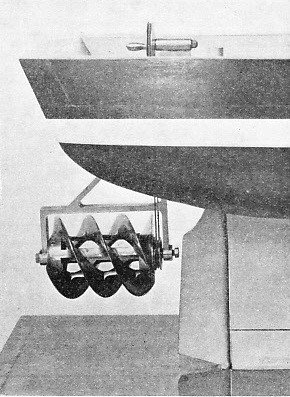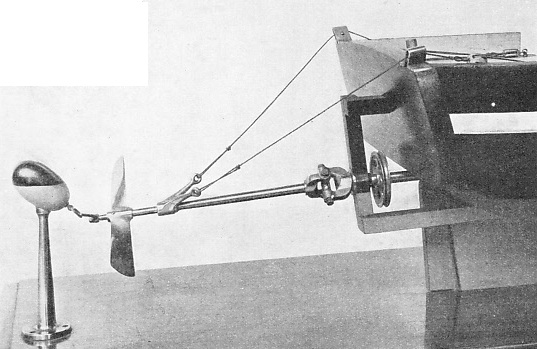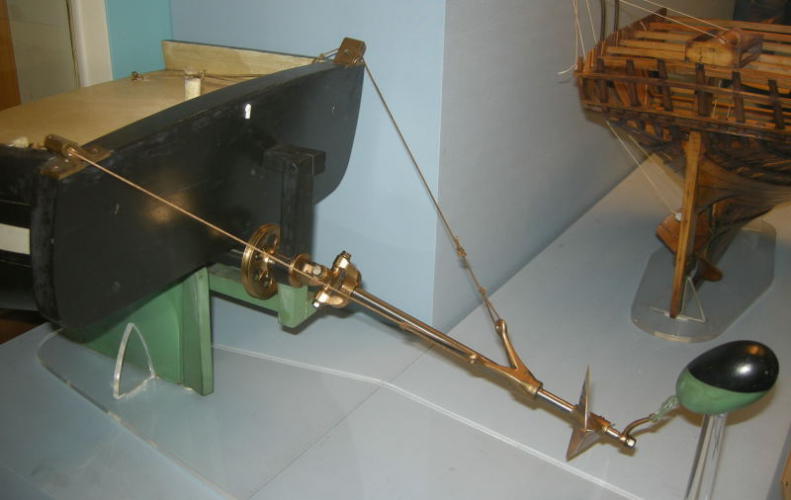Brown, David K. Before the Ironclad: Warship Design and Development, 1815–1860 (pp. 236-237). Pen & Sword Books. Kindle Edition.
The idea of a screw propeller was an old one; inventors had sought to use the Archimedian screw, used as a pump for centuries, or found inspiration in the windmill. Among many who made such proposals were Du Quet (1729), Daniel Bernoulli (1752) and Bramah (1785).
A more practical proposal came from Lyttleton in 1794, who patented a three start screw of length equal to one complete turn, which was mounted in a frame outside the ship. This screw was driven by men at a winch connected to the screw by ropes and pulleys. Trials were carried out by Colonel Beaufoy at Greenland Dock, Deptford, but were not very successful, the best speed achieved being only 2 knots.
Photo of model of the design taken from here, model has it at the stern but according to the article below, It was mounted in a frame that could be attached to the bow, stern or sides of a ship.
If on the sides, does this sound like it would be like a paddle wheel mounting but potentially wit less impact on the ship and where guns could be mounted.?
 www.shippingwondersoftheworld.com
www.shippingwondersoftheworld.com

A much more successful propeller was designed by Edward Shorter of Middlesex who obtained a patent for a ‘perpetual sculling machine’ on 1 March 1800. The two-bladed propeller was carried over the stern on a long inclined shaft with a universal joint near the ship, the weight of the propeller being taken by a float. In 1802, Shorter’s propeller was tried on the transport Doncaster in Gibraltar Bay. With eight men on the capstan which operated the propeller, the transport covered two miles at a speed of 1½ knots. The master, John Shout, and Captains Aylmer and Keats of warships in company, wrote enthusiastically to Shorter. A further trial was carried out at Malta in the presence of Admiral Bickerton who wrote to Shorter on 4 September 1802, ‘I think the plan a good one and that it may in many instances be useful’. Shorter seems to have been well aware of the advantages of using a steam engine to drive the propeller but this was never tried.
Photo of model of the design taken from here
 www.shippingwondersoftheworld.com
www.shippingwondersoftheworld.com

And from wiki

Note, on Bramah’s proposal wiki says
In 1785, Joseph Bramah of England proposed a propeller solution of a rod going through the underwater aft of a boat attached to a bladed propeller, though he never built it
Could Littleton’s and Shorter’s designs have been steam powered, Brown’s comment on Shorter’s design suggests it could.
If steam powered presumably a higher speed could be achieved compared to man powered?
How do the two designs compare to paddle wheels in terms of efficiency and vulnerability?
Both could be shot up, with Littleton’s design looking less vulnerable due to being below the waterline, but so could paddle wheels.
If Lyttleton’s proposal with an Archimedes screw type system was not possible, how about an situation with Francis Smith’s screw proposal in 1837 which saw in a fortuitous accident blades removed from the screw giving a propellor as we know it on each side.
The idea of a screw propeller was an old one; inventors had sought to use the Archimedian screw, used as a pump for centuries, or found inspiration in the windmill. Among many who made such proposals were Du Quet (1729), Daniel Bernoulli (1752) and Bramah (1785).
A more practical proposal came from Lyttleton in 1794, who patented a three start screw of length equal to one complete turn, which was mounted in a frame outside the ship. This screw was driven by men at a winch connected to the screw by ropes and pulleys. Trials were carried out by Colonel Beaufoy at Greenland Dock, Deptford, but were not very successful, the best speed achieved being only 2 knots.
Photo of model of the design taken from here, model has it at the stern but according to the article below, It was mounted in a frame that could be attached to the bow, stern or sides of a ship.
If on the sides, does this sound like it would be like a paddle wheel mounting but potentially wit less impact on the ship and where guns could be mounted.?
Development of the Screw Propeller - Shipping Wonders of the World
Steamships had been propelled by paddle wheels from the earliest days until the middle of the nineteenth century, when experiments with screw propellers were successfully carried out and the screw-type marine engine was gradually evolved.

A much more successful propeller was designed by Edward Shorter of Middlesex who obtained a patent for a ‘perpetual sculling machine’ on 1 March 1800. The two-bladed propeller was carried over the stern on a long inclined shaft with a universal joint near the ship, the weight of the propeller being taken by a float. In 1802, Shorter’s propeller was tried on the transport Doncaster in Gibraltar Bay. With eight men on the capstan which operated the propeller, the transport covered two miles at a speed of 1½ knots. The master, John Shout, and Captains Aylmer and Keats of warships in company, wrote enthusiastically to Shorter. A further trial was carried out at Malta in the presence of Admiral Bickerton who wrote to Shorter on 4 September 1802, ‘I think the plan a good one and that it may in many instances be useful’. Shorter seems to have been well aware of the advantages of using a steam engine to drive the propeller but this was never tried.
Photo of model of the design taken from here
Development of the Screw Propeller - Shipping Wonders of the World
Steamships had been propelled by paddle wheels from the earliest days until the middle of the nineteenth century, when experiments with screw propellers were successfully carried out and the screw-type marine engine was gradually evolved.

And from wiki

Note, on Bramah’s proposal wiki says
In 1785, Joseph Bramah of England proposed a propeller solution of a rod going through the underwater aft of a boat attached to a bladed propeller, though he never built it
Could Littleton’s and Shorter’s designs have been steam powered, Brown’s comment on Shorter’s design suggests it could.
If steam powered presumably a higher speed could be achieved compared to man powered?
How do the two designs compare to paddle wheels in terms of efficiency and vulnerability?
Both could be shot up, with Littleton’s design looking less vulnerable due to being below the waterline, but so could paddle wheels.
If Lyttleton’s proposal with an Archimedes screw type system was not possible, how about an situation with Francis Smith’s screw proposal in 1837 which saw in a fortuitous accident blades removed from the screw giving a propellor as we know it on each side.
Last edited:
